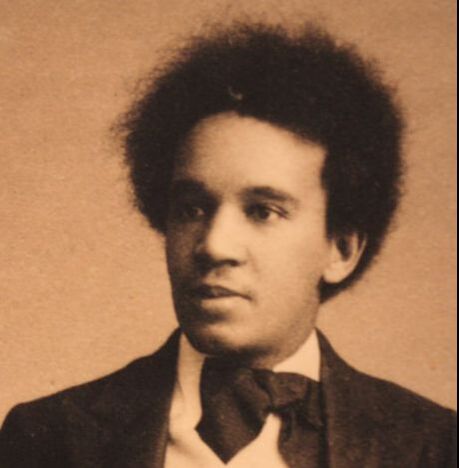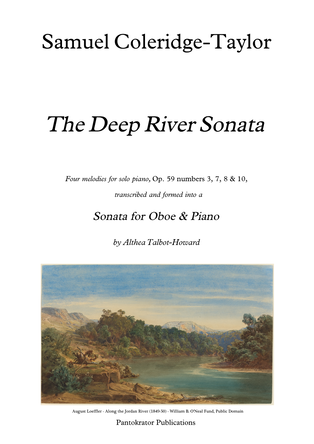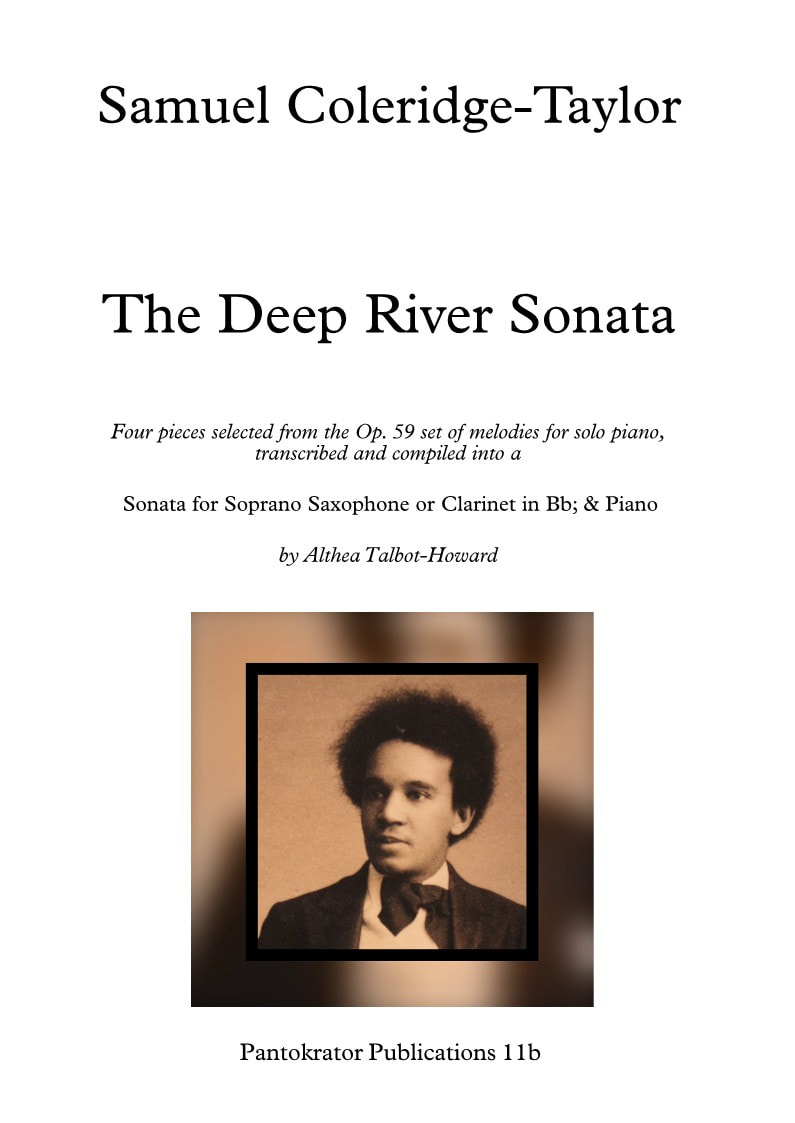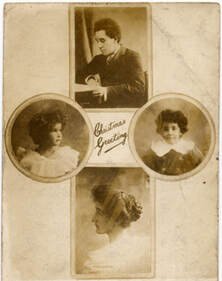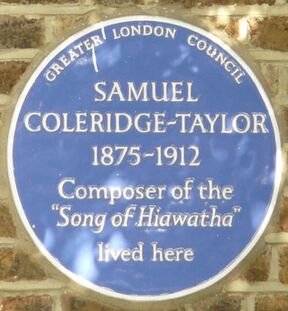The River Jordan flowing into the Dead Sea (Wikimedia Commons)
Samuel Coleridge-Taylor (1875-1912)
arr. Althea Talbot-Howard
The Deep River Sonata
for Oboe* & Piano
(Thata Nabandji, Oloba, Deep River, The Bamboula)
*or Soprano Sax or Clarinet in Bb
arr. Althea Talbot-Howard
The Deep River Sonata
for Oboe* & Piano
(Thata Nabandji, Oloba, Deep River, The Bamboula)
*or Soprano Sax or Clarinet in Bb
Introducing...
THE DEEP RIVER SONATA
(1904/2020/2022)
THE DEEP RIVER SONATA
(1904/2020/2022)
This new sonata for solo instrument & piano has been created from pieces selected from Samuel Coleridge-Taylor's Opus 59 set of 24 solo piano pieces. Built upon folk melodies from Africa, the Caribbean & the USA, Coleridge-Taylor completed the work in 1904. The sonata's central slow movement consists of Deep River. Shorter items begin and end the piece.
Hassan Anderson & David Korevaar play through The Deep River Sonata in rehearsal - July 2022
Louis Suc & Leo Nicholson give the British debut performance - June 2023
Louis Suc & Leo Nicholson give the British debut performance - June 2023
|
|
|
The Deep River Sonata - Samuel Coleridge-Taylor (1875-1912)
Four Melodies from Opus 59 - numbers 3, 7, 8 & 10
I Thata Nabandji - Interlude I Oloba (oboe solo) - II Deep River - Interlude II Oloba (piano solo) - III The Bamboula
Four Melodies from Opus 59 - numbers 3, 7, 8 & 10
I Thata Nabandji - Interlude I Oloba (oboe solo) - II Deep River - Interlude II Oloba (piano solo) - III The Bamboula
|
Samuel Coleridge-Taylor's Opus 59 set of melodies from the African Diaspora, published for solo piano in 1904, is a rich treasure trove of folk songs & spirituals which the composer presents in an intensely symphonic pianistic style. Deep River, no. 10 in the set, is the most well-known, having been transcribed for violin & piano by the renowned early-twentieth-century virtuosa, Maud Powell, in addition to many other arrangements of varying levels.
Thata Nabandji is one of four initial melodies hailing from 'South East Africa' - as mentioned in the score. Oloba is called a 'West African Folk-lore Song', whilst The Bamboula represents the Caribbean. Thata Nabandji is riven with emotional intensity. Oloba shines with the authentic sound, structure and rhythmic flexibility of African folksong; whilst The Bamboula is simultaneously passionate and ebullient. In the middle of these shorter items sits the pearl of great price: Coleridge-Taylor's moving interpretation of the renowned African-American spiritual, Deep River. |
Once I had completed my new arrangement of Deep River in 2020, I then began to consider creating an entire sonata from Opus 59, by book-ending Deep River with two shorter, faster pieces from the set. In order to retain the original, but completely unrelated, keys - and to facilitate smooth movement between them - I took the exposition from a fourth piece - Oloba - and used it to create two solo interludes that functioned both as harmonic bridges: and as a breathing space for the oboist after the sustained breath demands of Deep River.
|
The Deep River Sonata
(Op. 59 nos. 3/7/10 & 8) for Oboe (or alternative instrument) & Piano Duration: 10 mins Level: Intermediate to Advanced C- score for Oboe & Piano Bb score for Soprano Sax or Clarinet Please send a message via the Score Purchase & Contact Page, to obtain either score. |
|
Performance History
Debut Performance Friday 29 July 2022 IDRS Conference Recital, Grusin Hall, University of Colorado Boulder, USA Hassan Anderson, Oboe & David Korevaar, Piano WATCH ON YOUTUBE Second Performance Sunday 30 April 2023 DMA Recital & Composer Feature Concert, Voxman Music Building, The University of Iowa, Iowa City, IA, USA Lisa Ryoo, Oboe & Casey Dierlam Tse, Piano Third Performance/Live Radio Broadcast Saturday 17 June 2023 Live-to-Air recital at WFMT Radio, Chicago Zachary Allen, Oboe & Mio Nakamura, Piano WATCH ON YOUTUBE First British Performance Thursday 29 June 2023 Trinity Laban Black Culture 365 Composer Feature Concert #2, St. Alfege Church, Greenwich, London SE10 Louis Suc, Soprano Sax & Leo Nicholson, Piano WATCH ON YOUTUBE Fifth Performance Friday 4 August 2023 Bethel United Church of Christ, 315 E St Charles Rd, Elmhurst, IL 60126, USA Zachary Allen, Oboe & Jeffrey Panko, Piano |
Sixth Performance
Friday 1 September 2023 Fourth Presbyterian Church, 126 E Chestnut St, Chicago, IL 60611, USA Ashley Ertz, Oboe & Lillia Woolschlager, Piano LIVESTREAMED PERFORMANCE CURRENTLY UNAVAILABLE Seventh Performance Saturday 25 November 2023 William Wielgus, Oboe The Bamboula from The Deep River Sonata Recital - Palácio São Clemente, Rio de Janeiro, Brasil Eighth Performance Sunday 11 February 2024 Jennet Ingle, Oboe; Ellis Anderson, Piano Michigan City Chamber Music Festival Trinity Episcopal Church 600 Franklin Street, Michigan City, IN, USA WATCH ON YOUTUBE Ninth Performance Saturday 30 March 2024 at 1930 MDT (0230 BST/0330 CEST) Sara Renner, Oboe; Dena Kay Jones, Piano Faculty Recital, Fox Fine Arts Recital Hall, University of Texas El Paso 500 W University Ave, El Paso, TX, USA LIVESTREAM Tenth Performance Friday 24 May 2024 William Wielgus, Oboe & Mary-Victoria Voutsas, Piano The Bamboula from The Deep River Sonata St. Thomas' Episcopal Church, Dupont Circle, 1517 18th St NW, Washington, DC 20036, USA |
|
Biography of Samuel Coleridge-Taylor
Samuel Coleridge-Taylor was a bi-racial composer of English and Sierra Leonean descent. Born in south London in 1875, he was raised by his English family: a musical family which taught him so well that he gained a place - in the 1890s - at the Royal College of Music in London. His areas of study were Violin and Composition.
Coleridge-Taylor's principal Composition teacher was Charles Villiers Stanford (1852-1924). After leaving the RCM, Coleridge-Taylor gained work as a professional musician in his natal Croydon area, as a teacher and conductor. In 1899 he married Miss Jessie Walmisley, whom he had met whilst studying at the RCM, and they had two children: Hiawatha and Avril Coleridge-Taylor. Both children pursued musical careers in their adulthoods. |
|
Coleridge-Taylor found it difficult to earn sufficient income as a composer, but persevered until his early death at the age of thirty-seven. He experienced a number of successes en route, including three tours of the United States in the 1900s, and patronage by Sir Edward Elgar - also an alum of the RCM. His cantata Hiawatha's Wedding Feast was a runaway success - and it was his failure to make sufficient money from score sales that lead to the formation of the PRS - the Performing Right Society.
His Op. 59 set of piano melodies from the African diaspora caught the attention of American violin virtuosa Maud Powell, and she created her own, renowned arrangement of Deep River for Violin & Piano in 1904, as mentioned above. It was during these visits to the USA that Samuel Coleridge-Taylor was received at the White House by President Theodore Roosevelt. The composer died in England of pneumonia, in 1912. |
